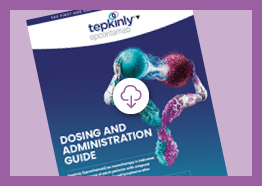Downloadable Resources
Using Tepkinly
Tepkinly Preparation and Administration: The vial method
An overview of the vial method for preparing Tepkinly, including the dilution of step-up doses (0.16 mg and 0.8 mg) and the preparation of the full 48 mg dose for subcutaneous administration. Watch this video for guidance on handling, storage, and preparation using the vial technique.
Tepkinly Preparation and Administration: The syringe method
An overview of the syringe method for preparing Tepkinly, including the dilution of step-up doses (0.16 mg and 0.8 mg) and the preparation of the full 48 mg dose for subcutaneous administration. Watch this video for guidance on handling, storage, and preparation using the syringe technique.
Tepkinly Mode of Action animation
The Tepkinly mechanism of action is explained in this video which shows how by binding simultaneously to CD3 on T cells and CD20 on B cells, epcoritamab forms an immune synapse – inducing cytokine release and T-cell–mediated killing of malignant CD20-expressing cells.1
Dr Mark Bishton, Associate Professor and Honorary Consultant Haematologist, Nottingham University Hospitals NHS Trust
Dr Bishton works at a Trust that is a large tertiary referral centre responsible for the population of Nottinghamshire, and it also provides a tertiary referral service, including bispecific antibody therapies, for patients in Derbyshire and Lincolnshire
Dr Dima El-Sharkawi, Consultant Haematologist, Royal Marsden Hospital, London
Dr El-Sharkawi works at an academic and tertiary centre and has a specialist interest in looking after patients with lymphoma, including DLBCL patients with relapsed / refractory disease
Considering QoL outcomes in treatment discussions
How do quality of life outcomes impact on treatment choice in the 3L+ R/R DLBCL setting?
Dr Dima El-Sharkawi considers treatment discussions in 3L+ DLBCL, including the major aims of treatment for both patients and clinicians, balancing efficacy and safety, and incorporating quality of life measures into discussions.
Dr Satyen Gohil, Consultant Haematologist, University College London Hospitals NHS Foundation Trust, London
Dr Gohil works at the University College London Hospitals, one of the largest lymphoma units in the UK. He specialises in treating patients with lymphoma from diagnosis through multiple lines of treatment
Dr Wendy Osborne, Consultant Haematologist, Newcastle upon Tyne Hospitals NHS Foundation Trust
Dr Osborne looks after DLBCL patients in the North-East of England at a tertiary referral centre that also provides CAR-T therapy and allogeneic stem cell transplantation services
Patient selection for bispecific therapy
How is the evolving DLBCL treatment landscape changing patient selection and treatment decision making?
Hear Dr Wendy Osborne consider how the advent of bispecific therapies is impacting on patient selection and treatment choice in the 3L+ R/R DLBCL setting.
The importance of parallel planning
Parallel planning in the R/R DLBCL setting
Listen to Dr Wendy Osborne discuss the importance of having conversations with patients and their families on parallel planning early in the treatment pathway to facilitate shared decision making in the R/R DLBCL setting.
By clicking the link above, you will leave the AbbVie Pro website and be taken to the eMC PI portal website.
Abbreviations
CNS=clinical nurse specialist; DLBCL=diffuse large B-cell lymphoma; R/R=relapsed/refractory.
References
- Tepkinly Summary of Product Characteristics.
UK-EPCOR-250225. Date of preparation: November 2025.
Adverse events should be reported. Reporting forms and information can be found at yellowcard.mhra.gov.uk.
Adverse events should also be reported to AbbVie on GBPV@abbvie.com












